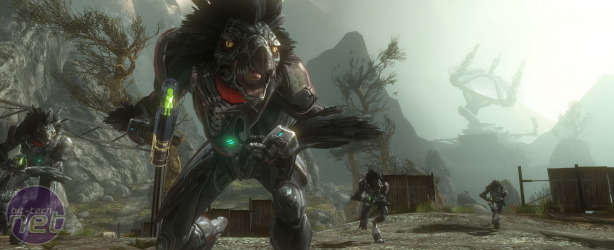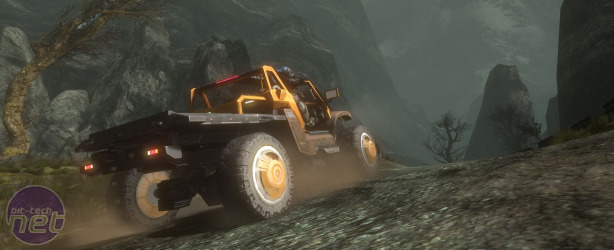
Reach for the Stars
Reading this far, it might sound as if we don’t like Halo: Reach at all, but that’s not true – it’s just that we don’t like the story. The actual game part of Reach is actually rather excellent. It’s easy sometimes to dismiss Halo as catering to the lowest common denominator of console gamers, but whether that’s true or not doesn’t change how slick the game feels. Within seconds you can be drifting through the air, lobbing plasma grenades and scoring sniper headshots from the hip in a beautiful delirium. At times there's no barrier between your thoughts and your on-screen actions.If that fact is old news to you though, then you’ll be pleased to know that Reach has clustered in a bunch of new features and ideas which elevate it above the previous titles. A little. There are plenty of new things to get accustomed to: new space-based dogfights and modular enhancements for your Spartan armour that provide everything from jetpacks to shields, to name two. However, the biggest addition is player customisation.
Again, it’s tempting to dismiss the customisation options. The popular knee-jerk opinion of people passing as we played was ‘Oh, so they’ve copied Call of Duty?’ – which doesn’t really do it justice. As well as having various loadouts that change your starting arsenal in multiplayer, you can now earn credits to unlock aesthetic improvements. We were never going to be blown away by a wardrobe of helmets and shoulder pads, but we can’t fault it either. It’s a nice little way of increasing the long-term appeal as you rush to collect them all, if nothing else.
There are some fun new multiplayer modes too and, while there’s nothing as groundbreaking as Halo 3’s Forge mode, there are some worthwhile ideas in the mix. Headhunter, where killed players drop skulls that can be collected and deposited back at base for points, is a particular favourite even if Generator Defence will likely see more activity. In Defence one team is tasked with destroying three generators, while the other team defends – simple and to the point.
Reach doesn’t rely overly on the new content either, bringing plenty of tweaks and improvements to existing features too. ODST’s Firefight mode returns, alongside classics such as Slayer, as does an enhanced Forge mode that now lets you alter levels more easily through a snap-to function. Combine that with an improved Veto system that makes finding the matches you want a bit easier and the multiplayer side has clearly improved just as iteratively as you’d hope.
 Then again, as with all multiplayer games, it’s more about who you play with than what you’re playing – and as ever, playing with friends is still the preferred option. Anonymous, stranger-filled matches are risky ventures. That applies to singleplayer too, if you plan on playing the campaign co-operatively, which is a good way to buoy up the otherwise faltering story that often threatens to drag Reach down.
Then again, as with all multiplayer games, it’s more about who you play with than what you’re playing – and as ever, playing with friends is still the preferred option. Anonymous, stranger-filled matches are risky ventures. That applies to singleplayer too, if you plan on playing the campaign co-operatively, which is a good way to buoy up the otherwise faltering story that often threatens to drag Reach down.Weighing up the two very distinct halves of Reach, we can’t deny that we end up looking at it favourably. It’s a fun game and that can’t be denied, even though it’s clear that Bungie has desperately tried to reach for something beyond simple fun. 'Meaningful, dramatic, epic' – these are the targets that Bungie has aimed for. Sadly, nearly every shot has gone awry and the actual result is 'predictable, samey and repetitive.' The game is still very enjoyable, but only because Halo has always felt very good to play – while we have had fun with Reach, it’s not been anything more lasting than that.
Score Guide

MSI MPG Velox 100R Chassis Review
October 14 2021 | 15:04











Want to comment? Please log in.